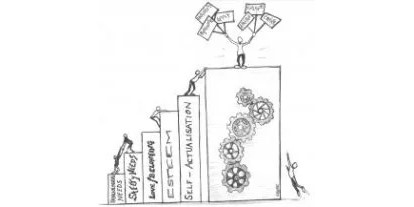Learning by numbers—Maslow and Bloom suggest not

Maslow’s Hierarchy & Bloom’s Taxonomy -Artwork by Susannah Bishop—Ethos CRS
By John Preston
Maslow hierarchy of needs and Bloom’s taxonomy of learning
Humans are curious creatures. On one level, we are capable of profound understanding and complex cognition. On another we are completely dependent on the most basic physiological and emotional needs being met before we can realise our higher-order potential.
In the earlier part of last century, Abraham Maslow devised the Hierarchy of Needs to explain the pre-requisites for humankind to access their higher nature. Once basic, physiological needs are met—food and shelter—humans apply themselves to the increasingly higher order concepts of safety, belonging, esteem and, finally, self-actualisation or fulfilment.
Dr Benjamin Bloom, an educational psychologist from the 1950s, developed a similar hierarchical approach—Bloom’s Taxonomy—but his applied to the domains of learning. Bloom observed individual’s learning progress from remembering through understanding, application, analysis and evaluation, culminating in creation.
For infant or juvenile learning, as much emphasis needs to be given to meeting Maslow’s hierarchy as Bloom’s taxonomy. Children need to be fed, feel safe and belong. Only then can they advance through Bloom’s domains. A settled family life, good schools and great teachers are, therefore, the prerequisites for a child’s successful learning journey.
Adult education, however, generally assumes Maslow’s hierarchy has been met—at least as far as ‘esteem’—and this is largely our experience with adult learning in the public sector. Nevertheless, this should never be taken for granted—but more on this later.
A Modern Context
At Ethos CRS, our learning development principles are solidly based on understanding and applying Bloom’s Taxonomy in a way aligned with the modern world.
An individual’s basic education gives them the capacity to recall, recognise and understand facts and information. At the next level, the individual cultivates the ability to apply these remembered concepts and ideas in their everyday work lives.
Further on into Bloom’s taxonomy, the development of higher-order analytical skills allows professionals to dissect and compartmentalise information. Breaking concepts down into manageable pieces opens up the professional’s capacity to analyse the issues. But, what now? With analytical skills under their belt, reviewing—or evaluating—results to assess the viability or usefulness of developed ideas is the next logical progression.
Ultimately, our public sector professionals devise and develop ideas that contribute to public value. We need to unbridle their creativity while managing their enthusiasm so the desired public policy outcomes can be delivered.
Program delivery to adults is considerably more successful if it refers both to Maslow and to Bloom. The assumption that the adult learners have already sufficiently ascended Maslow’s hierarchy to engage in Bloom’s higher-level learning domains is a risky one.
The Ethos CRS approach is to ensure that we address the fundamentals of belonging (Maslow) in the way we conduct our training, while also developing the higher-order learning domains (Bloom). We achieve this through non-competitive and participative learning, grounded in encouraging participants to access each learning domain sequentially—to climb Bloom’s taxonomic pyramid.
Clearly this is not learning by numbers. It is a coherent and robust strategy that has proven itself time and again.
Contact us at service@ethoscrs.com.au for a customised program for your organisation. Ethos CRS provides most of the policy programs for the Australian Public Service Commission (APSC) through their National learning and development calendar.

